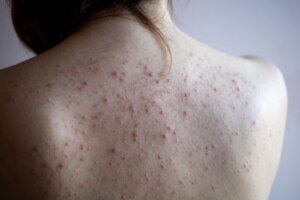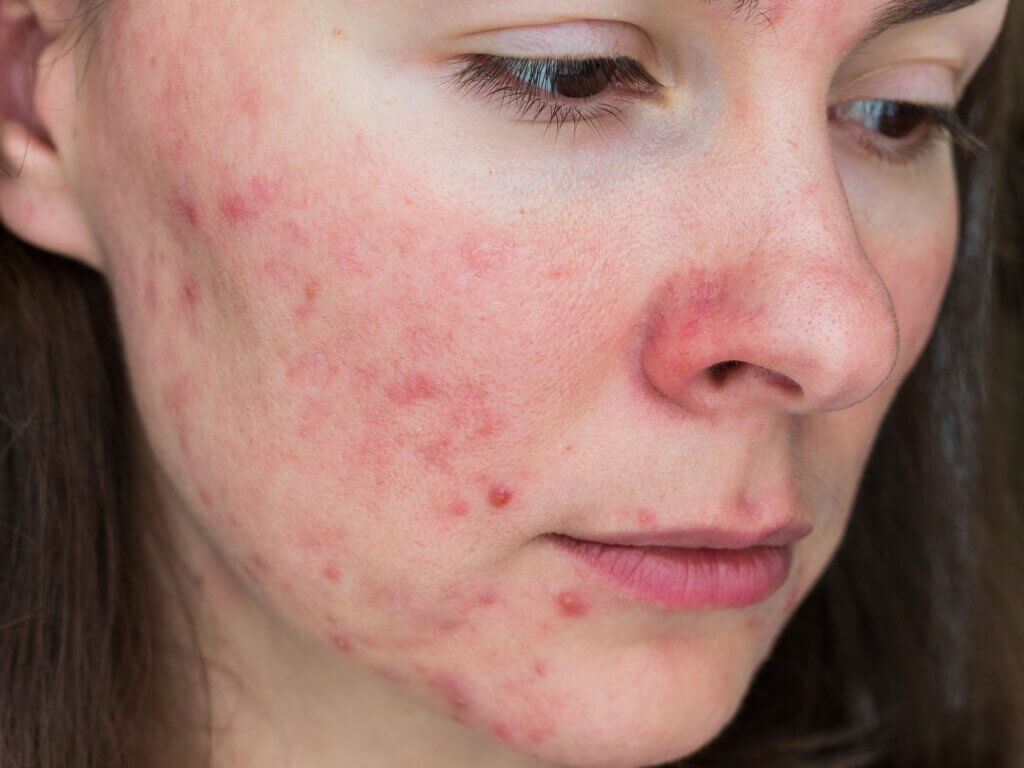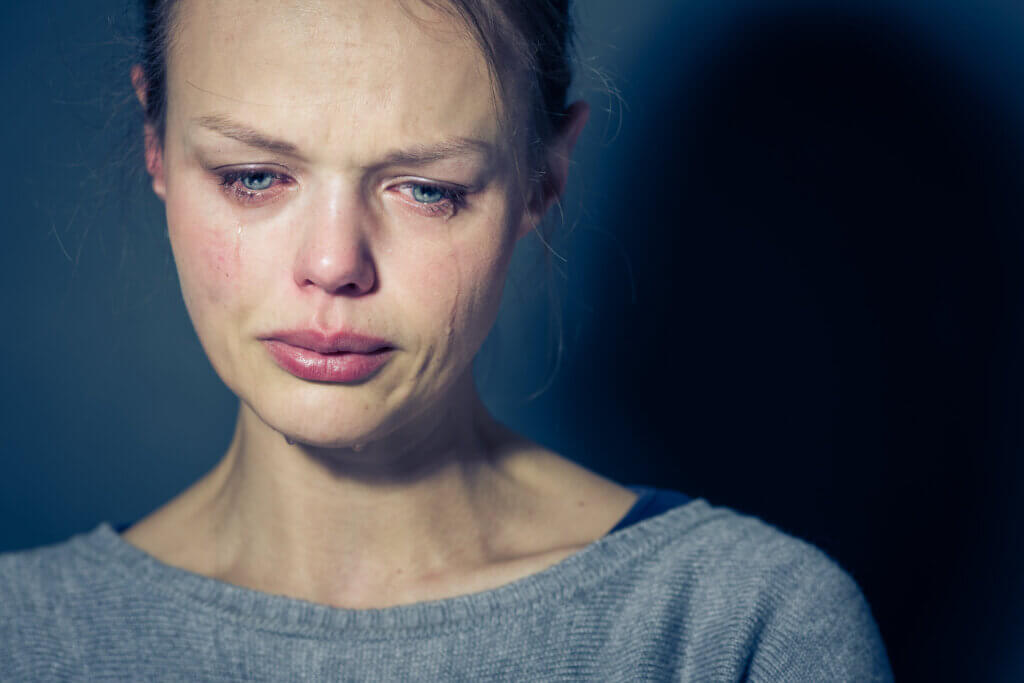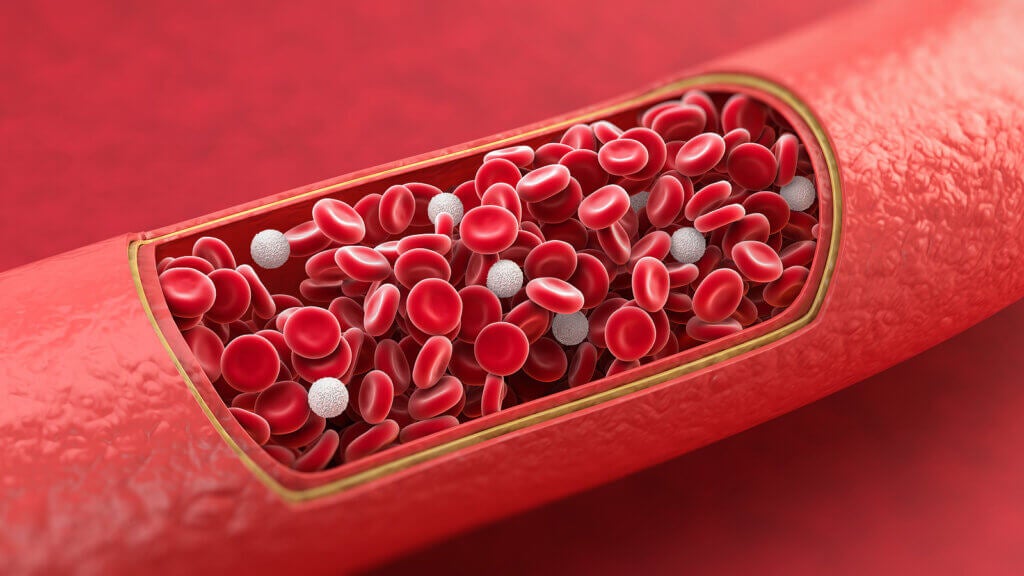Red Dots on the Skin: Why Do They Appear?

Red dots on the skin can appear for various reasons. Infectious processes, underlying diseases, allergic processes, changes in the weather, and others may be behind them. Most of the time, it’s a benign condition, although it’s important that people are aware of the evolution and symptoms in order to seek medical attention when necessary.
In the following paragraphs, we’ll list 7 causes of red dots on the skin. Differentiating one condition from another at home is complicated, so our guide only serves as a reference before consulting a dermatologist. Avoid self-medicating or underestimating this manifestation, as medical judgment in these contexts is essential in order to rule out complications.
7 causes of red dots on the skin
There’s no single diagnosis of red dots on the skin. In practice, a hundred conditions can explain them, so that the complementary symptoms, shape, tone, location, and context in which they develop determine which process they correspond to. That being said, we want to tell you about 7 possible explanations for red dots on the skin.
1. Petechiae
Petechiae are small red spots the size of a pin that appear on the skin or mucous membranes. As experts point out, the points reach a maximum of 2 millimeters and don’t fade when applying pressure. They’re very common, especially in children and young people.
They are not a disease in themselves, but rather a symptom of an underlying problem, particularly thrombocytopenia (decreased number of platelets in the blood).
Specifically, petechiae appear when capillaries leak under the skin. Pressure can cause leaks, so coughing hard, sneezing excessively, lifting heavy weights, giving birth, and other strenuous activities may be behind it. Infectious processes, injuries from blows, the intake of medications, and vitamin C deficiency are also among the culprits.
2. Rosacea

Rosacea is a chronic skin disease of unknown causes that appears mainly on the face. As researchers indicate, it’s more common in middle-aged white women. Four main types are distinguished: Erythematotelangiectatic, papulopustular, phymatous, and ocular. It usually appears unexpectedly.
Red dots on the skin are accompanied by other symptoms such as thick skin, small visible blood vessels, irritated skin, bumps or pimples, and watery eyes. Some triggers make symptoms worse, such as exposure to sunlight, medications, and alcohol. It’s more common in people between the ages of 30 and 60.
3. Atopic dermatitis
Atopic dermatitis is a very common chronic skin disorder in children. It’s estimated that up to a fifth of the world’s population develops the disorder, and among them, 20% manifest it throughout their lives. In addition to red dots on the skin, the patient experiences itching and the presence of scales. Almost all cases are restricted to the neck, elbows, knees, ears, and hands.
The condition is also known as eczema, and since the irritation is often very intense, people can injure themselves by scratching. They also tend to develop sleep problems and low self-esteem. Its triggers aren’t fully known, but it’s to develop due to a combination of immune and environmental factors.
4. Contact dermatitis
It’s thought that up to 20% of the world’s population shows extreme sensitivity to the interaction of the skin with nearby objects (clothing, fragrances, watches, and so on). This is known as contact dermatitis, a very common inflammatory condition. It manifests more frequently in women and most cases are related to allergic episodes.
The main symptoms of the disease are irritation, peeling, swollen and dry skin, and the presence of red dots on the skin when interacting with objects. Not all episodes are allergic, some are triggered by the weakening of the top layer of the skin. These cases are known as irritant contact dermatitis.
5. Keratosis pilaris
Keratosis pilaris is characterized by the presence of tiny bumps on the skin that are red, pink, or brown in color. It’s very common, so much so that some estimates indicate that it affects up to 80% of adolescents and 40% of adults at least once in their lives. The most affected areas are the arms, thighs, and buttocks.
This condition isn’t accompanied by other symptoms and usually manifests unexpectedly. Its causes are unknown, although people with Down syndrome and obese patients tend to develop it more than other groups. Experts have also found that they’re common in diagnoses of diabetes, atopic dermatitis, and ichthyosis vulgaris.
6. Heat rash

Heat rash, better known as milaria in the clinical setting, is characterized by blockage of the eccrine sweat glands and ducts. This results in small red dots on the surface of the skin, which often cause itching and irritation. The most affected areas are those where sweat accumulates the most, namely, the armpits, feet, groin, and back.
It’s very common during the summer, or in people who live in particularly hot areas. Experts distinguish between three types: Crystallina, rubra, and profunda. The intake of certain medications and strenuous physical activity can also favor its appearance. Cases usually resolve on their own after a few minutes or hours.
7. Cherry angiomas
Cherry angiomas are small, noncancerous spots on the skin that are usually shiny and dome-shaped. They’re also known as senile angiomas, as their presence increases with age. As specialists point out, the spots or dots have an extension between 1 and 2 millimeters and tend to appear on the trunk and upper extremities.
Other possible explanations for red dots on the skin are ringworm, drug rashes, pityriasis rosea, blood spots, swimmer’s itch, lichen planus, psoriasis, or consequences of acne vulgaris. Although most cases are benign, we recommend that you seek medical assistance if the condition causes you a lot of itching or discomfort or if it develops chronically.
Red dots on the skin can appear for various reasons. Infectious processes, underlying diseases, allergic processes, changes in the weather, and others may be behind them. Most of the time, it’s a benign condition, although it’s important that people are aware of the evolution and symptoms in order to seek medical attention when necessary.
In the following paragraphs, we’ll list 7 causes of red dots on the skin. Differentiating one condition from another at home is complicated, so our guide only serves as a reference before consulting a dermatologist. Avoid self-medicating or underestimating this manifestation, as medical judgment in these contexts is essential in order to rule out complications.
7 causes of red dots on the skin
There’s no single diagnosis of red dots on the skin. In practice, a hundred conditions can explain them, so that the complementary symptoms, shape, tone, location, and context in which they develop determine which process they correspond to. That being said, we want to tell you about 7 possible explanations for red dots on the skin.
1. Petechiae
Petechiae are small red spots the size of a pin that appear on the skin or mucous membranes. As experts point out, the points reach a maximum of 2 millimeters and don’t fade when applying pressure. They’re very common, especially in children and young people.
They are not a disease in themselves, but rather a symptom of an underlying problem, particularly thrombocytopenia (decreased number of platelets in the blood).
Specifically, petechiae appear when capillaries leak under the skin. Pressure can cause leaks, so coughing hard, sneezing excessively, lifting heavy weights, giving birth, and other strenuous activities may be behind it. Infectious processes, injuries from blows, the intake of medications, and vitamin C deficiency are also among the culprits.
2. Rosacea

Rosacea is a chronic skin disease of unknown causes that appears mainly on the face. As researchers indicate, it’s more common in middle-aged white women. Four main types are distinguished: Erythematotelangiectatic, papulopustular, phymatous, and ocular. It usually appears unexpectedly.
Red dots on the skin are accompanied by other symptoms such as thick skin, small visible blood vessels, irritated skin, bumps or pimples, and watery eyes. Some triggers make symptoms worse, such as exposure to sunlight, medications, and alcohol. It’s more common in people between the ages of 30 and 60.
3. Atopic dermatitis
Atopic dermatitis is a very common chronic skin disorder in children. It’s estimated that up to a fifth of the world’s population develops the disorder, and among them, 20% manifest it throughout their lives. In addition to red dots on the skin, the patient experiences itching and the presence of scales. Almost all cases are restricted to the neck, elbows, knees, ears, and hands.
The condition is also known as eczema, and since the irritation is often very intense, people can injure themselves by scratching. They also tend to develop sleep problems and low self-esteem. Its triggers aren’t fully known, but it’s to develop due to a combination of immune and environmental factors.
4. Contact dermatitis
It’s thought that up to 20% of the world’s population shows extreme sensitivity to the interaction of the skin with nearby objects (clothing, fragrances, watches, and so on). This is known as contact dermatitis, a very common inflammatory condition. It manifests more frequently in women and most cases are related to allergic episodes.
The main symptoms of the disease are irritation, peeling, swollen and dry skin, and the presence of red dots on the skin when interacting with objects. Not all episodes are allergic, some are triggered by the weakening of the top layer of the skin. These cases are known as irritant contact dermatitis.
5. Keratosis pilaris
Keratosis pilaris is characterized by the presence of tiny bumps on the skin that are red, pink, or brown in color. It’s very common, so much so that some estimates indicate that it affects up to 80% of adolescents and 40% of adults at least once in their lives. The most affected areas are the arms, thighs, and buttocks.
This condition isn’t accompanied by other symptoms and usually manifests unexpectedly. Its causes are unknown, although people with Down syndrome and obese patients tend to develop it more than other groups. Experts have also found that they’re common in diagnoses of diabetes, atopic dermatitis, and ichthyosis vulgaris.
6. Heat rash

Heat rash, better known as milaria in the clinical setting, is characterized by blockage of the eccrine sweat glands and ducts. This results in small red dots on the surface of the skin, which often cause itching and irritation. The most affected areas are those where sweat accumulates the most, namely, the armpits, feet, groin, and back.
It’s very common during the summer, or in people who live in particularly hot areas. Experts distinguish between three types: Crystallina, rubra, and profunda. The intake of certain medications and strenuous physical activity can also favor its appearance. Cases usually resolve on their own after a few minutes or hours.
7. Cherry angiomas
Cherry angiomas are small, noncancerous spots on the skin that are usually shiny and dome-shaped. They’re also known as senile angiomas, as their presence increases with age. As specialists point out, the spots or dots have an extension between 1 and 2 millimeters and tend to appear on the trunk and upper extremities.
Other possible explanations for red dots on the skin are ringworm, drug rashes, pityriasis rosea, blood spots, swimmer’s itch, lichen planus, psoriasis, or consequences of acne vulgaris. Although most cases are benign, we recommend that you seek medical assistance if the condition causes you a lot of itching or discomfort or if it develops chronically.
- Guerra, K. C., Toncar, A., & Krishnamurthy, K. Miliaria.
- Martin SF, Rustemeyer T, Thyssen JP. Recent advances in understanding and managing contact dermatitis. F1000Res. 2018;7:F1000 Faculty Rev-810. Published 2018 Jun 20.
- Mikkelsen CS, Holmgren HR, Kjellman P, et al. Rosacea: a Clinical Review. Dermatol Reports. 2016;8(1):6387. Published 2016 Jun 23.
- McGrath A, Barrett MJ. Petechiae. In: StatPearls [Internet]. Treasure Island (FL): StatPearls Publishing; 2022 Jan.
- Pennycook KB, McCready TA. Keratosis Pilaris. In: StatPearls [Internet]. Treasure Island (FL): StatPearls Publishing; 2022 Jan.
- Qadeer HA, Singal A, Patel BC. Cherry Hemangioma. In: StatPearls [Internet]. Treasure Island (FL): StatPearls Publishing; 2022 Jan.
- Thomsen SF. Atopic dermatitis: natural history, diagnosis, and treatment. ISRN Allergy. 2014;2014:354250. Published 2014 Apr 2.
- Thomas M, Khopkar US. Keratosis pilaris revisited: is it more than just a follicular keratosis?. Int J Trichology. 2012;4(4):255-258.
Este texto se ofrece únicamente con propósitos informativos y no reemplaza la consulta con un profesional. Ante dudas, consulta a tu especialista.







